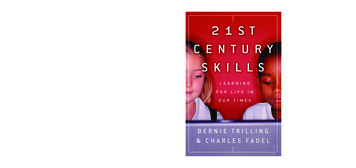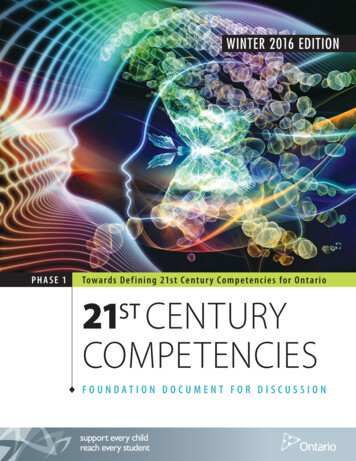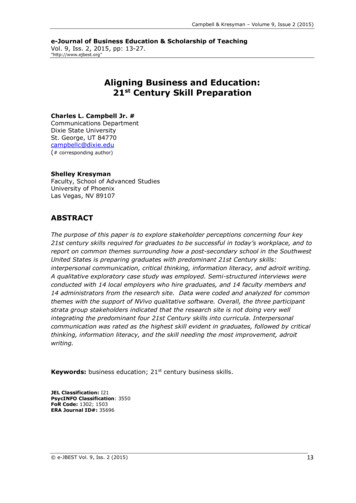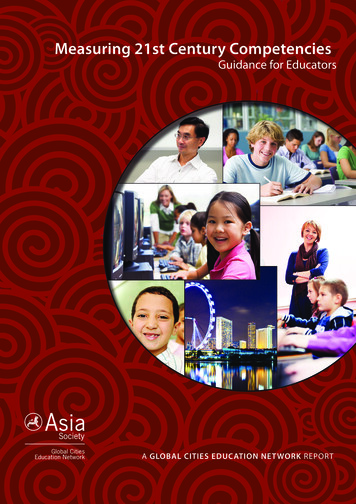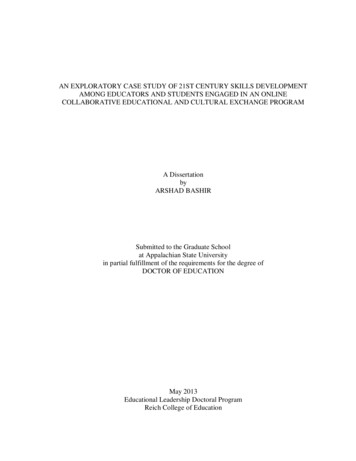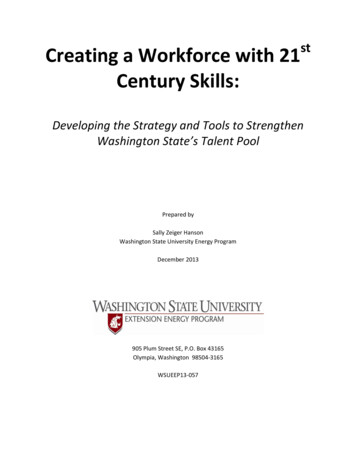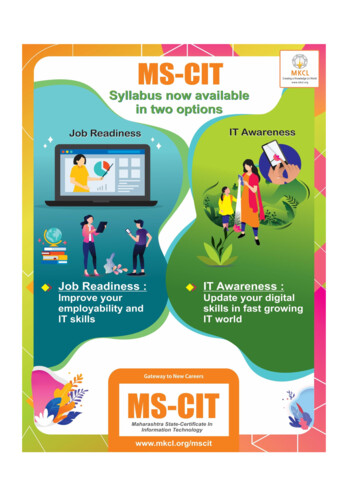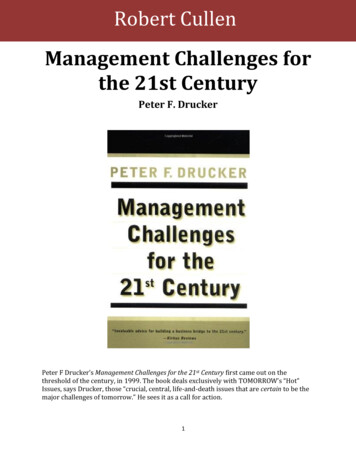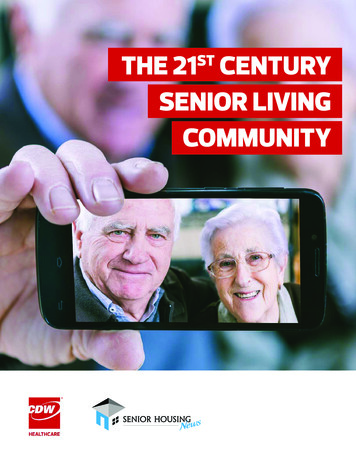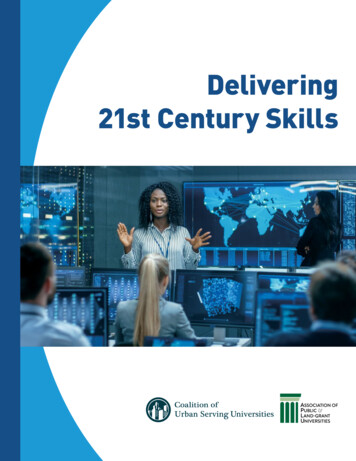
Transcription
Delivering21st Century Skills
COALITION OF URBAN SERVING UNIVERSITIESThe Coalition of Urban Serving Universities (USU) is a president-ledorganization committed to enhancing urban university engagementto increase prosperity and opportunity in the nation’s cities and totackling key urban challenges. The Coalition includes public urbanresearch universities representing all U.S. geographic regions. TheUSU agenda focuses on creating a competitive workforce, buildingstrong communities, and improving the health of a diverse population.The Coalition of Urban Universities (USU) has partnered with theAssociation of Public and Land-grant Universities (APLU) to establishan Office of Urban Initiatives, housed at APLU, to jointly lead an urbanagenda for the nation’s public universities.ASSOCIATION OF PUBLIC AND LAND-GRANTUNIVERSITIESThe Association of Public and Land-grant Universities (APLU) is aresearch, policy and advocacy organization representing over 230public research universities, land-grant institutions, state universitysystems, and affiliated organizations. Founded in 1887, APLU isNorth America’s oldest higher education association with memberinstitutions in all 50 U.S. states, the District of Columbia, four U.S.territories, Canada, and Mexico. Annually, member campuses enroll4.7 million undergraduates and 1.3 million graduate students, award1.1 million degrees, employ 1.3 million faculty and staff, and conduct 41 billion in university-based research.June 2019BDelivering 21st Century Skills
ContentsIntroduction1The Challenge: Thriving in a Volatile and Unpredictable Digital Future3Technology3Populations3Shortage of Skilled Talent4A Partisan Divide4The Hidden Cost Crisis421st Century Competencies for All Learners7The Implication of 21st Century Skills for Universities11Curriculum and Instruction Redesign11New Curriculum, New Relationships11Rethinking Finance Models and Pricing Structures12An Emerging New Way of Doing Business: Innovations from the Field15University Innovations by Category17Pathways and On-ramps for a Broader Set of Learners17Curriculum Redesign17Badges, Microcredentials, and Certifications1821st Century Employer Partnerships18Strategic Community Partnerships19Rethinking the University Enterprise through a 21st Century Skills Lens20Rethinking Financial Models20Conclusion21COV ER IM AGE: GORODENKOFF/ISTOCK PHOTO.COM
“If we want things to stayas they are, things willhave to change.”Giuseppe Tomasi di LampedusaThe Leopard
IntroductionThe role of higher education has always beento prepare learners to thrive in life and ina career in the world of today and into thefuture. Equally, higher education has provided adirect benefit to society and was the main engine forsocial and economic mobility. However, to continueto deliver on this core mission, the university hastransformed over time in response to economic,social, and technological changes: It redefineditself as it moved through the industrial age andthen embraced the hands-on professions (e.g.,accounting and health) and then a more global anddiverse society. Today, to maintain that mission,higher education must transform again to meet theeconomic and social needs of a digital world.This paper sketches out a road map for highereducation that outlines those broader socioeconomic changes, extrapolates their implicationsfor both learning and the structure of the universityenterprise, and provides examples of how universitiesare innovating to meet these challenges.R AW PIX EL /ISTOCK PHOTO.COMDelivering 21st Century Skills1
2Delivering 21st Century Skills
The Challenge:THRIVING IN A VOLATILE AND UNPREDICTABLEDIGITAL FUTUREThe pressures for university change areincreasing in size, speed, and intensity, andthey intersect and overlap in unpredictableand highly complex ways. These pressures includeaccelerating technological advances, populationchanges across many dimensions, and the need fordifferent skills. RAPID OBSOLESCENCE. The rapidity of technologychange affects how universities invest and canhamper their change process. For example,university technology planning cycles tend to belonger than the cycle of innovation, which canmake technology plans obsolete before they areeven implemented.TechnologyPopulations ROBOTICS, AI, AND VIRTUAL REALITY. Studies byMcKinsey, Oxford, and others predict that the riseof robots and other forms of artificial intelligencemay trigger the loss of up to 50% of current jobsover the next 20 years.1 Even if this number isan overestimate, the implication is clear: notjust individual jobs but whole job types will beeliminated. Moreover, this technology changeimpacts different regions in the country and theglobe. For example, nationally, the ratio of robotsto people is higher in the Midwest and parts of theSouth than in the rest of the country.2 RACE, ETHNICITY, AND EQUITY. New collegeclasses are becoming more diverse. In someregions, that shift is happening rapidly. Researchindicates that people of color, primarily Hispanic,will account for most of the increase in thenumber of high school graduates.4 These shiftshave important implications for student success,as over 90% of high school graduates will enrollin a higher education institution.5 And yet, about60% of learners who enroll in a four-year coursecomplete their degree, and only 40% of thosewho enroll in a two-year course complete it. Thecompletion rates are lower among students ofcolor. Only 41% of all African-American studentswho began at a four-year college in 2012 earneda degree in six years. And for Hispanic students,the degree completion rate is 49.5%.6 Strategies toimprove degree completion must center on equityof access and outcomes.SIPHOTOGR A PH Y/ISTOCK PHOTO.COM CLOUD COMPUTING. Cloud computing is enablingthe diffusion of online courses (which areimproving in quality and decreasing in price),allowing them to reach deep into underservedmarkets. In time, online courses will become adirect challenge to the tuition costs of the existinguniversity ntent/uploads/Press-release-WorkingLearners .org/content/Research/researchproject.aspx?i till-surprise-youDelivering 21st Century Skills3
RISE OF NONTRADITIONAL LEARNERS. Astraditional college-aged populations haveflattened in regions in the U.S., specifically in theNortheast and Midwest, there has been an influxof nontraditional learners (i.e., stopouts, dropouts,etc.) entering higher education institutions. In fact,70%, or 14 million, students work while in college,43% of which are low-income and a third of whichare over 30.7 Adult and transitioning populationscan have very different needs around education(e.g., convenience and access, family support,pricing structures) compared to traditionalstudents. DIGITAL NATIVES AND GEN Z. Long accustomedto working across digital devices and platforms tobuild or supplement their own learning agenda,Gen Z may challenge universities’ standardapproaches to teaching and learning. According toresearch by Pearson,8 Gen Z have a higher regardfor a college education, teachers, and learning thanmillennials, and Gen Z learn and engage digitallydifferently from millennials. In a nutshell, Gen Zspend more time with visual and game contentonline and prefer YouTube (millennials preferFacebook), in-person group activities, and learningapps or interactive games rather than books(preferred by millennials) as their approach tolearning. Critically, 59% of Gen Z report that theybelieve YouTube contributes to their education.Shortage of Skilled TalentOne of the most complex challenges facing highereducation is unpacking the multitude of issueswrapped up in the concept of lack of skilled workers,which includes1) lack of technical workers, which may or maynot need a four-year degree;2) lack of sufficient STEM graduates;3) lack of certain skill types in college graduates(e.g., team working, time management, problemsolving, communication);4) lack of sufficient workers within an identifiablework category (e.g., cybersecurity, nursing); and5) upgrading and reskilling existing workers to ahigher or different level.For example, only 11% of employers believecolleges do an effective job preparing learners.9Translating that insight into strategies andtactics is not as simple as identifying thoseskills, but it requires continual assessment andreassessment of skill needs.A Partisan DividePublic support for colleges and universities hasdeclined, especially as questions around affordabilityand the “value added” of degrees take root in thepublic discourse. According to a survey by PewResearch Center,10 a majority of Republicans andRepublican-leaning independents (58%) say collegesand universities have a negative effect on the country.Democrats and Democratic-leaning Independents(72%) report colleges and universities have a positiveeffect. These findings are a wake-up call and anopportunity to rethink costs to the student and tothe institution.The Hidden Cost CrisisThere is a growing concern around how to supportlearners who face significant financial challengeseither close to graduation or from reenrolling ifthey are forced to stop out. The National StudentClearinghouse notes two-thirds of all studentswith at least a year of enrollment left school, andof these, about two-thirds are under 40.11 Studentswho stop out with unpaid bills join the populationof adults with some college and reduced wageearning capabilities. More ominous, they maycarry an accumulated debt load they cannot easilyor quickly pay off, which almost ensures financialinstability and an inability to accumulate wealthfor a significant proportion of their lifetime. Notonly is this a direct barrier to student success and7 s-release-WorkingLearners FINAL.pdf8 /The-NextGeneration-of-Learners final.pdf9 da-education-ecp-inaugural-report-2017.aspx10 san-divisions-in-views-of-national-institutions/11 SC Signature Report 7.pdf4Delivering 21st Century Skills
a roadblock to the efforts to boost college degreeattainment, it is a loss for the students and theirfamilies and for our employers and our communities,given how close these students are to graduation.This situation has prompted a call for institutionsto test initiatives that address these growingfinancial challenges, such as low-cost degrees,campaigns that guarantee financial support forlocal college-attendees, reclamation grants, andcompletion grants.W UT W H A NFOTO/ISTOCK PHOTO.COMDelivering 21st Century Skills5
6Delivering 21st Century Skills
21st Century Competenciesfor All LearnersThe confluence of all the pressures discussedabove has profound implications for whatlearners need to know to survive and thrivetoday and in the future and how this knowledgeis delivered. The National Association of Collegesand Employers (NACE) identified seven corecompetencies that all learners require, and theseremain important and relevant for answering thisquestion. Those competencies are1) critical thinking/problem solving,2) oral/written communication,3) teamwork/collaboration,4) information technology application,5) leadership,6) professionalism/work ethic, andSK Y NESHER /ISTOCK PHOTO.COM7) career management.NACE’s framework aligns learner outcomes toemployer needs, which is necessary to succeedin the workforce. Given all of the wider changesin motion, are learner outcomes e enough? ThePartnership for 21st Century Learning (P21) offersa different lens for exploring 21st century skills.Developed by practitioners to better integrate skillsinto the teaching of core disciplines, this frameworkrecognizes that education is about the masteryof skills needed for work, life, and citizenship.These skills are interconnected in the process of21st century teaching and learning, and includethe following:Delivering 21st Century Skills Life and career skills Flexibility and adaptability Initiative and self-direction Social and cross-cultural skills Productivity and accountability Leadership and responsibility Information, media, and technological skills Information literacy Media literacy Information, communication, and technologyliteracy Learning and innovations skills Creativity and innovation Critical thinking and problem solving Communication and collaborationWhile these skills are an excellent place to start, therise of artificial intelligence is expanding this list,and will require universities to transform how theydo business. Joseph Aoun’s recent book Robot-Proof:Higher Education in the Age of Artificial Intelligencelays out an additional set of literacies and cognitivecapacities that are necessary to survive and thrivein an era of smart machines and the increasingautomation of ever more jobs. He argues the goal isto continue to develop the skills that are uniquelyhuman, and doing that means incorporating theNACE skills, the P21 set, and beyond. Human skillsinclude not only communication, critical thinking,leadership, and teamwork but also the core human7
elements of curiosity, empathy, creativity, culturalagility, and entrepreneurialism. Here is what Aounrecommends adding to the curriculum, design, andsequencing of higher education:New literacies DATA LITERACY, to navigate in a world defined bycontinuous connectivity and information flows,and to make sense of data coming from bothpeople and machines TECHNOLOGY LITERACY, to understand the basicsof how machines, now ubiquitous, work with anability to automate processes as needed HUMAN LITERACY, which focuses on humanities,communication, and the growing importanceof designCognitive capacities SYSTEMS THINKING, or thinking holistically andmaking sense and connections among disparatepieces and ideas ENTREPRENEURSHIP, which applies creativethinking to economic endeavors, to developworkarounds and solutions in extremeenvironments that are becoming more common CULTURAL AGILITY, to help learners work withpeople from other places and with widely differentperspectives to contextualize information tounderstand people and things CRITICAL THINKING AND PROBLEM SOLVING,or evaluating vast amounts of information toformulate well-reasoned claims, while buildingcapacity to analyze situationsIn addition to cognitive skills, professional andacademic credentials, emotional, creative, and otherhuman skills also lead to resilience and adaptabilityin the 21st century. These include emotionalintelligence, anticipation, contextual competence,authenticity, and social connection and innovation.Labor market data underscores the importance ofthese skills. According to a recent Strada report,“human skills like leadership, communication andproblem-solving are the most in demand skills inIn fact, like Aoun, the authorsof the Strada report agree thatdelivering what is truly neededrequires real universitytransformation to serve abroader cohort of learnersacross a lifetime.the labor market.”12 Moreover, the report cites thatmore liberal arts graduates than computer scienceand engineering graduates have been entering thetechnology market, although the report is quickto follow-up that liberal arts may be necessarybut insufficient to meet the needs of learners andemployers. In fact, like Aoun, the authors of theStrada report agree that delivering what is trulyneeded requires real university transformation toserve a broader cohort of learners across a lifetime.Notably, the skills and competencies discussed thusfar have neither focused on an individual discipline(e.g., math) nor have centered on a particularindustry. This does not mean that industry-specificskills do not matter, but 21st century skills referto what all learners need to know irrespective offocus, discipline, or career path, which will changesignificantly over a lifetime and across many jobs,careers, and gigs.In fact, there is clear overlap between 21stcentury skills and industry core competencies. Forexample, the National Center for BiotechnologyInformation identifies the following competenciesneeded for healthcare workers: providing patientcentered care, working in multidisciplinary teams,employing evidence-based practices, applyingquality improvement, and using informatics anddata. While this list is specific to healthcare, thecongruence between these skills and the overarchingcompetencies required for all learners is apparent.12 and/8Delivering 21st Century Skills
MONK E Y BUSINES SIM AGES /ISTOCK PHOTO.COMBeing able to integrate precise industry needs—whichwill be changing rapidly over time—means buildingdeep partnership with employers and other partnersto keep the curricula agile and in step with changingsocial and economic conditions and the skills andcompetencies needed to navigate them.While the identification of core 21st centurycompetencies and the recognition that implementingDelivering 21st Century Skillsthese requires re-envisioning of the work of theuniversity are critical, another key insight fromAoun’s book is the need to ground this transformationin learning science. The implications of this ideaare equally profound, underscoring the need forcurriculum redesign that is not just academic andorganizational but also behavioral, designed in away to maintain motivation, curiosity, and a lovefor learning.9
PHONL A M A IPHOTO/ISTOCK PHOTO.COM10Delivering 21st Century Skills
The Implication of 21st CenturySkills for UniversitiesDelivering education to meet the needs ofthe coming AI revolution and to a broadercohort of learners with diverse educationneeds, and to compete with emerging new businessmodels, suggests the following directions: curriculumredesign, re-engineering and deepening relationshipswith the stakeholders, and rethinking finance modelsand pricing structures.Curriculum and InstructionRedesignDelivering 21st century skills will likely require amore agile curriculum with more coherent on- andoff-ramps for a broader and more diverse cohortof learners, and will include some or all of thefollowing components. Integrating career and academic advisingthroughout the student journey, to help shapepathways and guide learners to better aligna course of study with career aspiration andnavigation. This will require more and betteruse of real-time labor market data to ensureskills and competencies and learning align withmarket demand. A more multidisciplinary approach to education,which includes cross-training across disciplines(e.g., ensuring English majors also have business,finance, and technical skills, and STEM andprofessional majors have the humanities skillsneeded) and the creation of, and the ability toleverage, experiential learning and real-worldproblem-solving opportunities to improve learners’integrative thinking. In this context, integrativethinking refers to making connections betweenwhat students learn in the classroom and whatthey see in the workplace. Building seamless, integrated, and customizableeducation and training pathways that are availableto learners to manage a lifetime of career andlife transitions. The foundation of this approachincludes a series of stackable badges, credentials,and certificates connected to credit that certifyworkforce competencies and provide new on- andoff-ramps for students and competency-basedassessments and frameworks that enable thoseseamless transitions in and out of the workforce.13New Curriculum, New RelationshipsThe future of education and the workforce callsfor renegotiating competencies and credentialsin already complex validation systems, whichare increasingly challenged by the entry of manynew players offering a wide range of credentials.Renegotiating competencies will require reenvisioning partnerships, which will be becomeincreasingly critical in a resource-constrained, highspeed environment. Partnerships between state,community, and educational organizations securequality alignment between the skills students learnand the skills students apply.13 -apprenticeship-expansion-report.pdfDelivering 21st Century Skills11
STATES. Workforce partnerships prepare learnersfor employment and support their progression,especially in high-demand industries, by aligningthe efforts of education and training programs.These partnerships require engagement and buyin from key state stakeholders. State leaders areleveraging colleges and universities to advanceeconomic and workforce outcomes, includingnontraditional education, grants, and strategicemployer and community partnerships. TENNESSEE developed and implemented“Reconnect,” a program that allows adults 25and older enter postsecondary education toreskill and upskill. PENNSYLVANIA has begun re-aligning academicprograms and providing academic flexibility tomeet specific regional needs. COMMUNITIES. Partnerships require multipleperspectives and complementary needs fromtraining providers, community resources, andorganizations. Community partnerships providethe opportunity to leverage individual knowledge,assets, and resources of diverse organizations.Through workforce partnerships, employers earnskilled workers, and local organizations gainaccess to pathways for their communities. UNIVERSITY OF WISCONSIN-MILWAUKEEpartnered with the Business Roundtableassociation to develop an initiative titled“Pathways to the Industrial AutomationWorkforce of the Future” to focus on theinterdisciplinary nature of the emergingdigital field and the need to develop talent whopossesses technical, business, and workplacecompetency. THE UNIVERSITY OF NEW MEXICO partneredwith the Presbyterian Healthcare Services andlocal anchor institutions to teach basic job skillsthat their entry-level workers, such as those injanitorial or food services positions, are morelikely to succeed and ultimately advance tobetter positions. MORGAN STATE UNIVERSITY partnered with theMaryland Department of Natural Resourcesto provide students with internships and skillstraining in emerging green careers and fields. EMPLOYERS AND INDUSTRY PARTNERSHIPS. Asit is clear, new types of employer and industrypartnerships are required to build the needed skillsfor the 21st century. The following are examples ofsuch partnerships: UNIVERSITY OF MEMPHIS partnered with WestTennessee Healthcare to help adult learnersmake faster progress toward earning a degree. ARIZONA STATE UNIVERSITY partnered withUber to provide a seamless pathway to fullyfund college degrees for Uber drivers and theirfamilies. WAYNE STATE UNIVERSITY partnered withMicrosoft to help train students for jobs inhigh demand.Rethinking Finance Models andPricing StructuresWith tuition rising, how universities deliver skillsis also an economic question. Key pressures on theuniversity business model include rising tuition,income stagnation, the declining value of the PellGrant, and state funding reductions. INCOME STAGNATION. A postsecondary educationis no longer a privilege of the advantaged few, butan individual necessity for economic growth. Ata time when the workforce is quickly changingand cost of tuition is rising, training, skills, andcredentials will determine success. However,since flattened and uneven wage expansion hasbeen a key factor driving the income inequalityin the United States, many students are unableto pay to complete degrees or are paying fordegrees unvalued by emergent industry leaders.Based on an analysis of the 2016 householdincome data from the Census Bureau, DeSilverreports that Americans in the top tenth of theincome distribution earned 8.7 times as muchas Americans in the bottom tenth ( 109,578versus 12,523). In 1970, when the analysis periodbegan, the top tenth earned 6.9 times as muchas the bottom tenth ( 63,512 versus 9,212).14 Astuition continues to rise, the ability for studentsand families to shoulder these increased costs isdeclining. A Sallie Mae survey15 has found “that14 or-decades/15 gher-education12Delivering 21st Century Skills
With tuition rising, howuniversities deliver skills isalso an economic question.Key pressures on theuniversity business modelinclude rising tuition, incomestagnation, the declining valueof the Pell Grant, and statefunding reductions.since the economic downturn in 2008, highereducation consumers have been more receptiveto lower cost alternatives such as communitycolleges or colleges closer to home in order toavoid the cost of living on campus.” Even morealarming, students from low-income families areless likely to enroll in or earn a baccalaureatedegree, even when their academic capability istaken into consideration. Only 9% of students fromthe lowest income quartile earn a baccalaureatedegree by age 24, compared to 77% for the topincome quartile.16 Historically underrepresented,low-income, and first-generation students areparticularly affected by the income stagnationand the rising cost of degrees. Addressing growingtuition costs is critical as many more studentsneed access to affordable and debt-free, qualitydegree options. The rise in tuition impacts allprospective college students; however, this issuethreatens campus diversity at public four-yearcolleges since students of color are less likely toenroll. A National Center for Education Statisticsreport notes the share of students coming fromcommunities of color at public two- and fouryear colleges rose significantly in the yearsleading up to these tuition increases.17 Budgetcuts trigger tuition and fee increases and willdeter students of color from attending college,inevitably jeopardizing the increase in diversityacross campuses. DECLINING VALUE OF THE PELL GRANT. Sinceits origin, the Pell Grant Program has been themost significant federal program that provideslow-income students need-based aid to covercosts associated with attending college. In the2017–2018 academic year, this grant assisted morethan 7 million students from low-income families,with incomes less than 40,000 a year.18 With thetuition cost rapidly increasing, the need for thePell Grant aid is even more important for studentsfrom low-income families. These students strugglewith the financial aid process and are unaware ofthe full costs of college (i.e., fees, room and board,books, etc.) and overestimate the cost of highereducation. These students rely on the support ofneed-based aid, such as the Pell Grant. GoldrickRab revealed that today the Pell Grant coversjust 29% of the average costs of tuition, fees, androom and board at public four-year colleges, itslowest level in more than 40 years and far belowthe 79% it covered in 1975.19 And Yeun highlightsthe Pell Grant data primarily focuses on first-time,full-time students, totaling 46% of all Pell Grantrecipients.20 But 40% of university and collegeundergraduate students are 25 and older, and itis estimated that this group will increase to morethan 9 million by 2024.21 Paying for a collegedegree is different for older students, but despitethe increase in the number of adult studentsentering universities and colleges, merit- andneed-based aid is targeted at traditional first-timestudents. DECREASE IN STATE FUNDING. The decrease ofstate and local funding has caused an increasein tuition and a decrease in student services and16 https://www.ed.gov/college17 6 306.20.asp18 d-average-grant-and-numberrecipients-over-time19 -economic-opportunity20 pdf21 s-cut-some-services-for-students-over-25Delivering 21st Century Skills13
JNEMCHINOVA /ISTOCK PHOTO.COMemployees. An Economics of Education Review22report has found that the pass-through rate ison average 25.7%, meaning that for every 1,000reduction in state appropriations per student, wewould expect the average students to pay 257more per year in college costs.”As more conversations around specificpartnerships, income stagnation, pricingstructures, and financial models arise, highereducation leaders must respond to the scarcityof funds amidst inconsistent support for collegedegrees. The pressure on institutions has spiked asthey work to ensure students earn a well-roundededucation with the skills necessary to thrive in thenew workforce.22 pii/S0272775717303618 (available at https://tinyurl.com/y6gxmgdw)14Delivering 21st Century Skills
An Emerging New Wayof Doing Business:INNOVATIONS FROM THE FIELDBefore exploring the changes in motion in theworld of practice, it is worth taking a momentto warn of potential dangers and wrongroads. As we noted above, there are pressures onuniversities to deliver a better workforce for today,when universities must stick to their core missionof molding learners for today and tomorrow. Thus,given the ran
21st Century Competencies for All Learners 7 The Implication of 21st Century Skills for Universities 11 Curriculum and Instruction Redesign 11 New Curriculum, New Relationships 11 Rethinking Finance Models and Pricing Structures 12 An Emerging New Way of Doing Business: Innovations from the Field 15 University Innovations by Category 17
